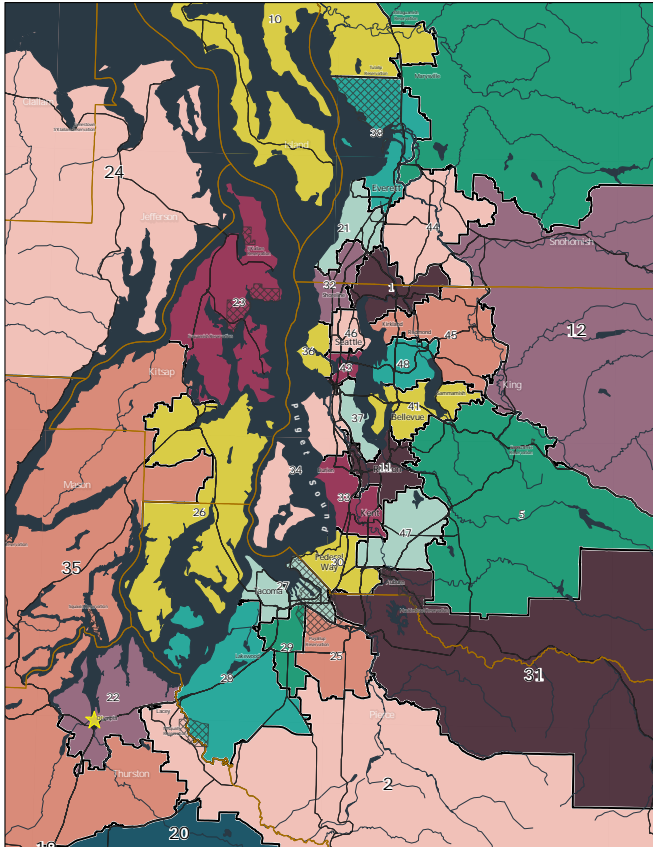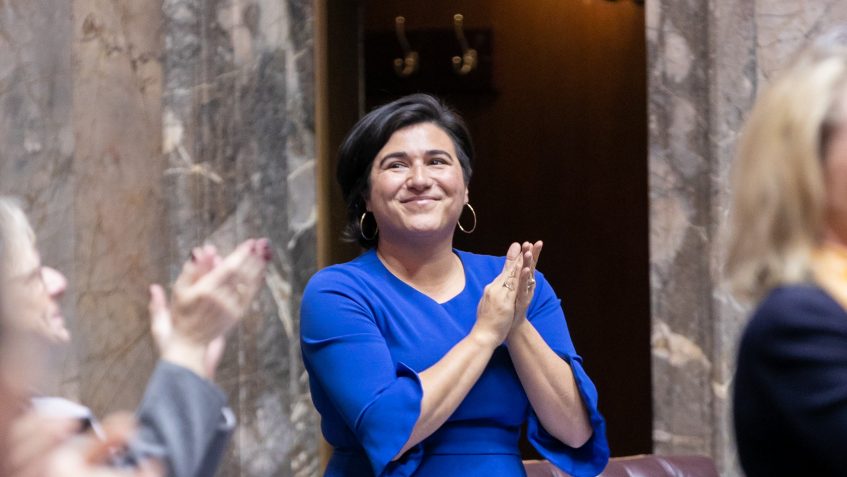
Political pundits always say that Midterm Elections are bad for the party that controls the presidency. Washington State didn’t get the memo, though. Democrats will end up picking up seats if results from this weekend’s ballot drops hold.
With the predicted Red Tide fizzling, Democrats have a solid chance to gain two Washington State House seats: one in Legislative District 10 (LD10) and one in LD26, plus a senate seat in LD42. That would make the Democratic advantages 29-20 in the state senate and 59-39 in the house, giving them a bit more breathing room to pass legislation. John Zingale also flirted making an unexpected pickup in LD18, but Republican Stephanie McClintock recovered by Thursday’s drop to take a two-point lead, and appears to be pulling away.
Marie Gluesenkamp Perez pulled off the biggest upset in the country in Washington’s 3rd Congressional District, flipping the red-leaning district for the first time in decades. That means Washington is sending eight Democratic Representatives to Congress and just two Republicans. Democrats will hold the U.S. Senate, and they have a shot to hold the House (even in an uphill Midterm were they were predicted to get crushed) thanks in part to the upset in Washington’s 3rd.
Perez is bringing “a populist, working class, rural voice back into the Democratic Party and [doing] it in a way that’s also economically progressive and socially progressive,” Sierra Club Seattle chair Robert Cruickshank said on a Hack and Wonks podcast appearance on Friday. He thought that presented a model for Democrats to emulate nationwide.
“Seeing the campaign she ran, the ads she ran, I think potentially point to a direction forward for Democrats as they really try to figure out what do they do about rural America,” Cruickshank added. “She’s winning right now because she has a huge lead in Clark County by double digits, but she’s holding her own in the rural parts of the county. She’s at 45-46% in Kelso-Longview area out on the rural Washington coast. She’s not going to win this race without running up decent numbers in the rural parts of the district. And so I think there’s a lot Democrats can learn from here.”
Perez received scant national support for her campaign, but a local political action committee associated with Fuse WA did spend $800,000 on her race, which proved to be enough when paired with the $3 million and change she raised herself. She was the right messenger with the right message, which can really amplify reach. It’s fairly damning that national Democratic party leaders sat this one out thinking it was a lost cause, but it is a big win for grassroots campaigning and for Fuse WA.
Nationally, many of the expected blue-to-red flips are not manifesting. Republicans may still eke out enough of the close races to narrowly take the House of Representatives, far short of the 30-seat majority projected by some models. Their hopes of retaking the U.S. Senate are dashed, however. Sen. Raphael Warnock’s runoff in Georgia will allow Democrats an opportunity to pick up a seat and provide some much needed breathing room in a 50/50 split Senate with some very wobbly “Democrat” votes in West Virginia Sen. Joe Manchin and Arizona Sen. Kyrsten Sinema. John Fetterman’s win in Pennsylvania provided a red-to-blue flip that will increase the Senate margin, at least if Warnock can hold his seat. The campaign strategy to woo blue collar workers paid off for Perez and Fetterman, who showed greater strength than normal in rural areas and improved margins with working class Whites, a demographic that has long been sliding toward Republicans.
What does the strong showing for progressives mean for future elections? Here’s some takeaways.
The Seattle metro’s blue wall continues to hold
The blue wall in the Seattle metro area held, despite considerable investment and hype from Republicans. Republicans continue to hold LD25 south of Puyallup, but that’s it as far as Puget Sound suburbia goes. Unlike swingier major metropolitan areas farther east, the suburbs in the Seattle metro aren’t that purple these days. They’re increasing looking solidly blue — even in years when Republicans think they’ve landed upon the perfect wedge issue like car tabs or crime.

Even more moderate “mainstream” Republicans struggled to break through, as former legislators like Chad Magendanz and Mark Harmsworth got no traction in their suburban races challenging supposedly weak Democratic incumbents and didn’t even make it close. LD5 and LD44 just don’t seem that swingy anymore, despite their former status as Republican bastions in the ‘burbs.
Pro-housing candidates resonated
In Democrat on Democrat races, the candidate with the stronger housing message tended to win. Look no farther than former Seattle Office of Housing director Emily Alvarado’s decisive win (with almost 70% of the vote) in LD34 for proof of this. This dynamic meant state legislature candidates endorsed by The Urbanist had a pretty strong showing, too. Darya Farivar (LD46), and Julia Reed (LD36), and Chipalo Street (LD37) are joining the state house after advancing through highly competitive open seat primaries in part because they spoke to the need for more housing at all income levels. These candidates supported statewide legislation to address the overly restrictive zoning that is hampering housing production. Just as recent polling has indicated, Washingtonians want action on housing, and they’re rewarding candidates who are credible and outspoken on this issue.
Smart candidates will adopt pro-housing policies as a consensus position and do better for it. With housing prices skyhigh and homelessness stubbornly persisting, Washingtonians aren’t looking to screw around on this issue any longer.
“Democrats have a mandate,” said political consultant Crystal Fincher (who is also a boardmember at The Urbanist) on the Hacks and Wonks podcast. “We saw to a degree that we haven’t before, to your point earlier, that Democrats ran hard on their values. And those who did and talked about a holistic view of public safety and bringing comprehensive public safety, who talked about housing being a human right, who talked about the absolute need to expand healthcare coverage, to house people – not simply temporarily shelter, but get people into housing reliably, to control out-of-control housing costs across the board — that these are things that Democrats across the state in battleground districts ran on and won handily on these things. Where there was some question — I know from some consultants, from some Democrats even in leadership — whether they did have a mandate to act on that, whether the public would support those things. We heard a resounding yes from voters. We saw candidates who pledged to take action on these things succeed.”
Fearmongering tough-on-crime candidates floundered
Locally, King County rejected a throwback tough-on-crime County Prosecutor candidate in Federal Way Mayor Jim Ferrell and elected the more progressive option in Leesa Manion instead. This cast serious doubts on the narratives from the 2021 election that tough-on-crime was back and progressives were deeply out of touch following Seattle City Attorney Ann Davison’s win over abolitionist Nicole Thomas Kennedy — not to mention the kind of campaign Mayor Bruce Harrell ran to win handily and Councilmember Sara Nelson ran to win narrowly. With his one-sided message, Ferrell absolutely failed to close in this race, despite polling showing a tight race headed into Election day.
Manion’s win means highly successful diversionary programs will continue and fewer people will need to rot in a jail (drinking brown tap water by the way) when reasonable alternatives exist for rehabilitation and meaningful amends to victims and society. Jail isn’t the fix for everything. King County’s even-year electorate seem to get that, even if centrist pundits were convinced punitive politics would be rewarded.
The miscalculation on crime was devastating for the state GOP, with most Republican candidates running campaigns centered on stoking crime fears, evoking images of a crime-ridden de-policed Seattle, and blaming Democrat policymaking. Those attacks just didn’t land. Voters apparently want to have a more nuanced discussion about what truly improving public safety would entail. Alas, Republicans (and some centrists Democrats) still want to act like it’s the drug war 1990’s all over again with only one solution: more cops, more jails, and longer jail sentences. Perhaps, policymakers will invest more in mental health, drug treatment, violence prevention, and the social safety net seeing the nuanced way the electorate is viewing public safety.
Election reform is popular
By an overwhelming margin, King County also passed a measure switching county races from odd- to even-year elections. Moreover, in dramatic fashion, Seattle is set to passed ranked choice voting with the first question of “should we change our election system” trailing until Saturday’s drop, when it jumped into the lead. Ranked choice easily dominated the second question over approval voting. Both measures were endorsed by The Urbanist Elections Committee. Both The Stranger and The Seattle Times opposed ranked choice voting measure (for different reasons), but the campaign was able to overcome that disadvantage. It was a full repudiation of approval voting, which is grabbing only 25%.
Switching local elections to even years would make the electorate much larger and more representative of the population in all its diversity. Odd-year elections have allowed a path for more conservative politicians like Ann Davison with tough-on-crime platform to survive in Seattle politics, but even year elections, perhaps with an assist ranked choice voting, could close the door on that possibility. The State Legislature would be wise to authorize the switching of municipal elections to even years across the state, finishing the work that King County has led on at the county level.
LD42, LD10, and LD26 are drifting blue
With four million of the state’s 7.7 million residents living in the Seattle metropolitan region, the metro blue wall is enough to control the legislature, but Democrats made some inroads elsewhere as well. Since Washington State used redistricting panel that was evenly split between Democrats and Republicans to draw the legislative map and the State Supreme Court has balked at taking over the process, redistricting didn’t carve out easy wins for Democrats outside of the Seattle metro where sheer numbers could not be overcome with Republican-friendly gerrymanders. Nonetheless, Democrats have prevailed in what were considered “even” districts as the state has drifted to the left, which happens to be what The Urbanist predicted.
LD10 is increasingly looking friendly to Democrats as Democratic Rep. Dave Paul is winning reelection (currently a 3.7 point lead and likely to grow) and Clyde Shavers looks well-positioned to pull out a close race against a Republican incumbent. Shavers was up just 29 votes Saturday, but there are plenty of votes still to count in Island County, which has been much friendlier turf for him.
Emily Randall is wining reelection in LD26, which is where Republicans thought they’d claw back a state senate seat. However, choosing an extremist with anger management issues in Rep. Jesse Young as their candidate likely did Republicans no favors. It’s going to be a nail-biter in Democrat Adison Richards campaign to flip a house seat in the district. Richard trailed by 613 votes Saturday, but remaining ballots weigh heavily toward Kitsap County where he has performed better. Richards won the two-candidate primary by 113 votes so we could be in for a similar squeaker.

Up north in Whatcom County, Democrats are currently on course to sweep LD42 despite fears the opposite would be the case. If Sharon Shewmake holds onto her lead, this would be a pickup of a senate seat for Democrats. Trump ally and anti-masker Doug Erickson used to hold this seat until he died after contracting Covid.
LD18 looked like it might be in play for Democrats on election night, but it drifted back toward Republicans in later returns. It appears Zingale will lose by about 5 points, which suggests the district in Portland exurbia could have flip potential if it continues to trend toward Democrats.
The 2022 election had some unique factors at play. Will voters mobilized by the Supreme Court’s attack on abortion rights stay mobilized? Will Republicans run fewer unhinged lightweight candidates? Will wavering Republicans come home after Trump finally exits the public stage? Maybe some dynamics will shift, but Washington is certainly a state where Democrats will continue to hold the advantage and progressive policies should be advancing. The Republican party is anti-urbanist and that constantly derides Seattle, undermines transit, and supports sprawl over much-needed urban housing while offering little positive vision for the state. That is simply not a winning formula.
Author’s note: This article has been updated with the paragraph about campaign spending and Fuse Washington.
Doug Trumm is publisher of The Urbanist. An Urbanist writer since 2015, he dreams of pedestrian streets, bus lanes, and a mass-timber building spree to end our housing crisis. He graduated from the Evans School of Public Policy and Governance at the University of Washington in 2019. He lives in Seattle's Fremont neighborhood and loves to explore the city by foot and by bike.


